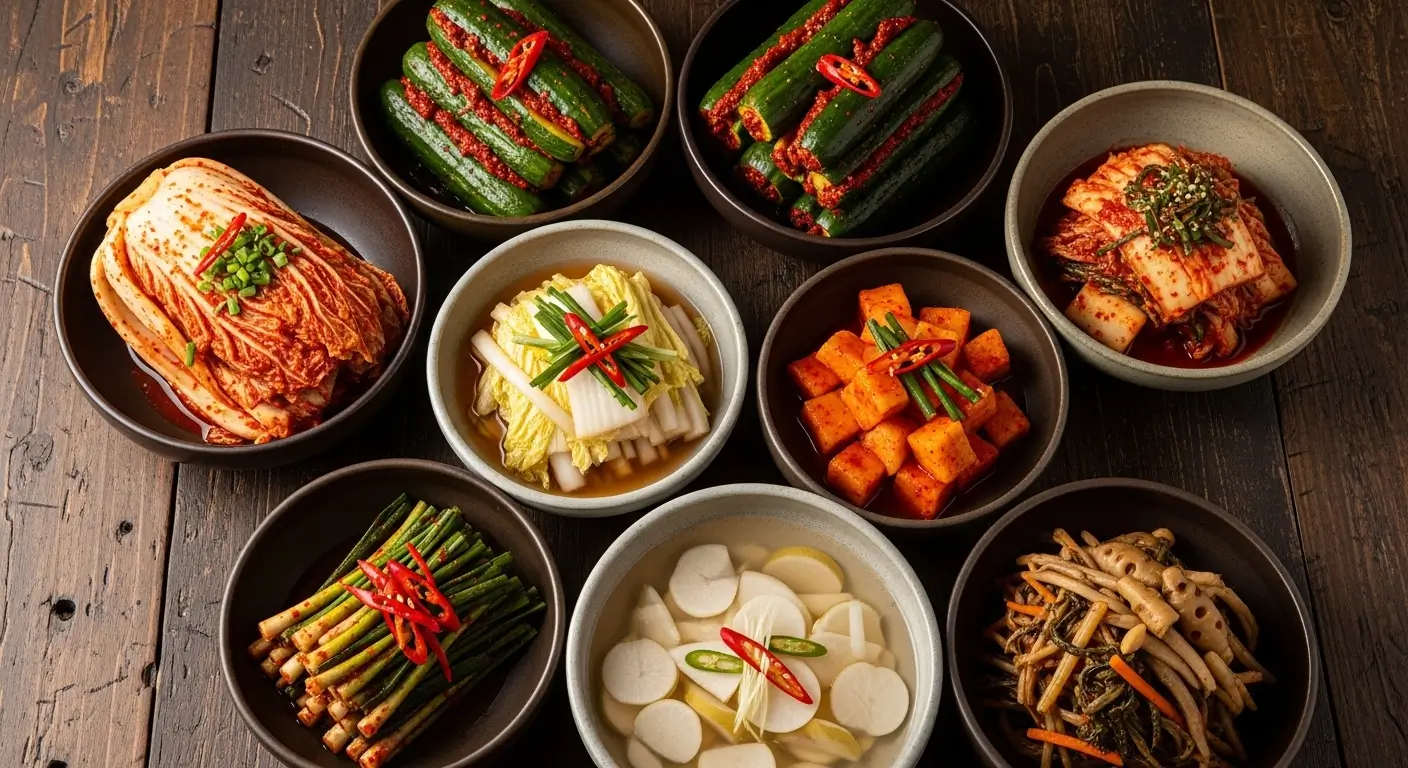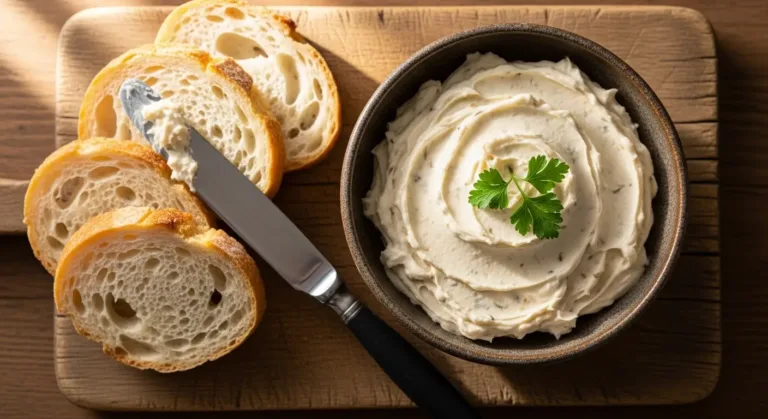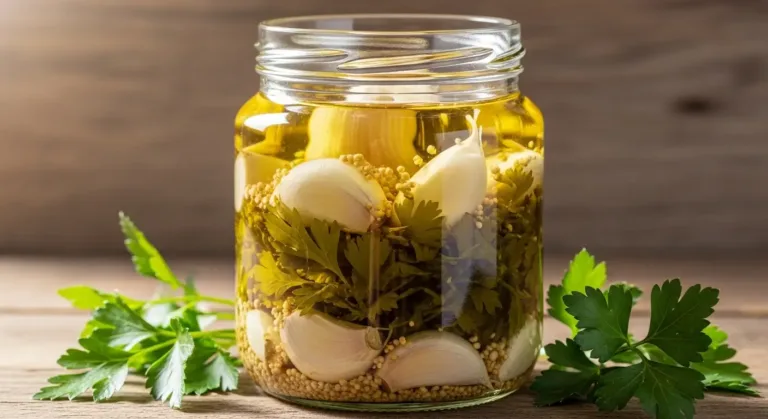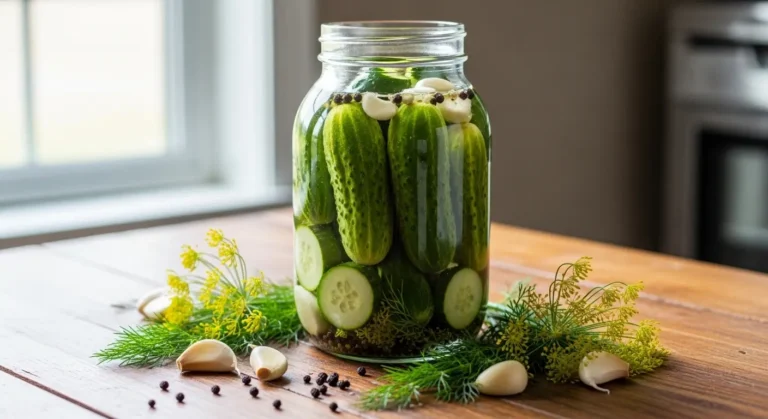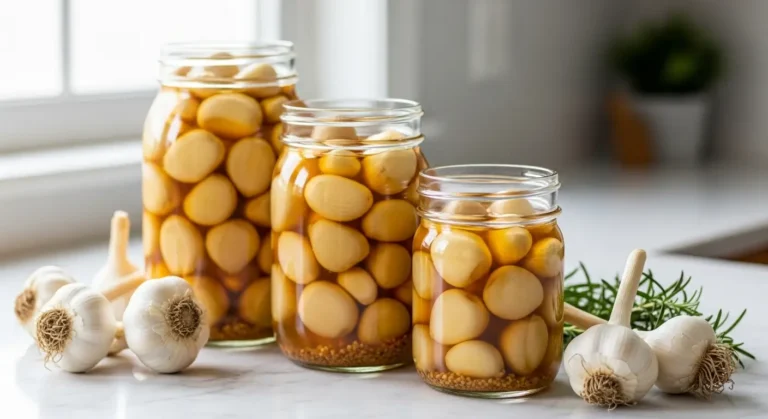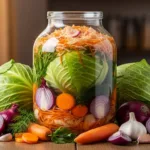So, you’ve tried kimchi once or twice and thought, “Yep, that’s some spicy cabbage”? Well, buckle up, friend, because kimchi variations are about to blow your mind. There’s a whole universe of kimchi variations beyond that classic napa cabbage stuff you get at Korean restaurants. We’re talking different veggies, crazy spice levels, and fermentation tricks that’ll make your taste buds do a happy dance.
Whether you’re into mild and mellow or “omg my mouth is on fire” spicy, there’s a fermented veggie version out there with your name on it. Plus, you’re getting all those gut-friendly probiotics that everyone’s obsessed with these days. Let’s check out seven awesome kimchi variations that’ll totally change how you think about fermented foods.
Classic Napa Cabbage Kimchi with a Twist
Traditional Foundation with Modern Updates
Okay, so traditional baechu kimchi is still the OG for good reason. It’s got that perfect combo of napa cabbage, gochugaru (that’s Korean red pepper flakes, by the way), garlic, ginger, and fish sauce. But here’s the fun part—you can totally make it your own!
A lot of people these days throw in some Asian pear or apple to balance out the heat. It adds this natural sweetness that makes the whole thing taste more complex as it sits there fermenting. And honestly? You can adjust the spice level however you want. Less gochugaru if you’re a spice wimp (no judgment!), or pile it on if you’re one of those people who puts hot sauce on everything.
Customizing Your Spice Level
The best thing about making kimchi at home is you’re the boss of the heat level. Traditional recipes use anywhere from a quarter cup to a full cup of Korean red pepper flakes, which is a pretty huge range. If you’re new to this whole spicy-fermented-food thing, start with just a tablespoon or two. You can always add more next time, but you can’t take it back once it’s in there!
As your kimchi sits around fermenting for 3-5 days, the flavors mellow out and get more interesting. Pro tip: tossing in a bit of sugar or honey helps tame the heat while feeding those good bacteria that make kimchi so healthy.
Discover great ideas like: How to Make Probiotic Pickles in Under 5 Days
Quick Cucumber Kimchi for Summer
Refreshing and Fast to Make
Among all kimchi variations, cucumber versions stand out for their speed. Oi kimchi (cucumber kimchi) is your best friend when you want that kimchi fix RIGHT NOW. Unlike cabbage versions that need days to do their thing, cucumber kimchi stays nice and crunchy and you can literally eat it within hours of making it.
Just slice up some pickling cucumbers, salt them quickly to get the moisture out, then toss with gochugaru, garlic, ginger, and green onions. Done! It’s perfect for summer when it’s hot and you want something refreshing but still packed with flavor. The cucumbers keep you hydrated while the spices give you that signature kimchi kick.
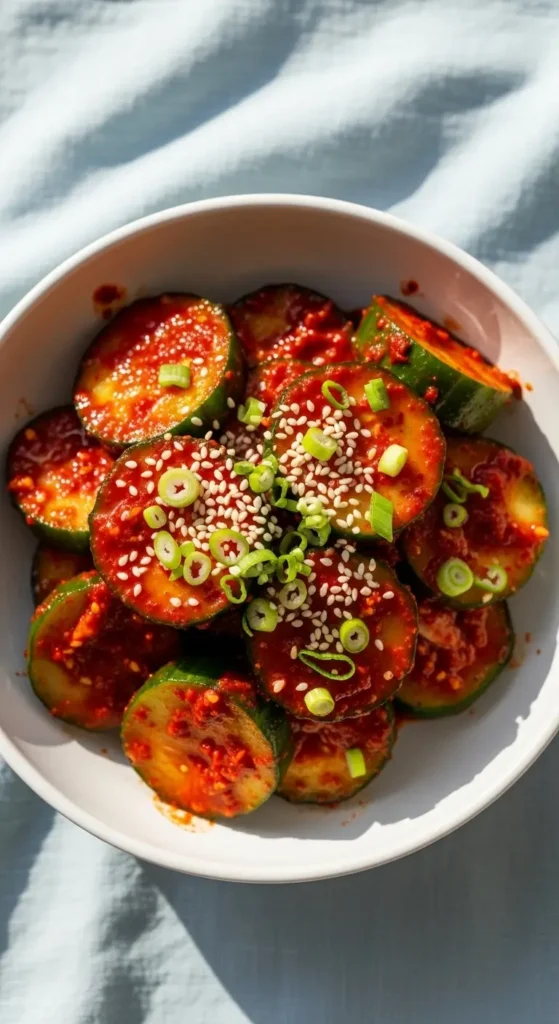
Best Cucumbers for Fermenting
Not gonna lie, cucumber choice matters here. Those small pickling cucumbers or Persian cucumbers work best because they’ve got fewer seeds and stay firmer. Skip the regular slicing cucumbers—they turn into mush way too fast. Look for the ones that are about 4-6 inches long with bumpy skin.
Oh, and always cut off the blossom end (that’s the flower end, not the stem end). It’s got enzymes that make your veggies go soft during fermentation, and nobody wants mushy kimchi.
Crunchy Radish Cube Kimchi
Satisfying Texture and Bold Flavor
One of the most texturally interesting kimchi variations is kkakdugi, made with cubed Korean radish, and the crunch factor is absolutely next level. Korean radish (sometimes called daikon) is sweeter and juicier than those little red radishes you get at the grocery store, which makes it perfect for fermenting.
You just peel it, cut it into little cubes (about 3/4-inch), then coat everything with a paste of gochugaru, garlic, ginger, green onions, and fish sauce. What you end up with is crunchy, spicy, sweet, and tangy all at once. It’s especially amazing with rich meat soups when you need something to cut through all that heaviness.
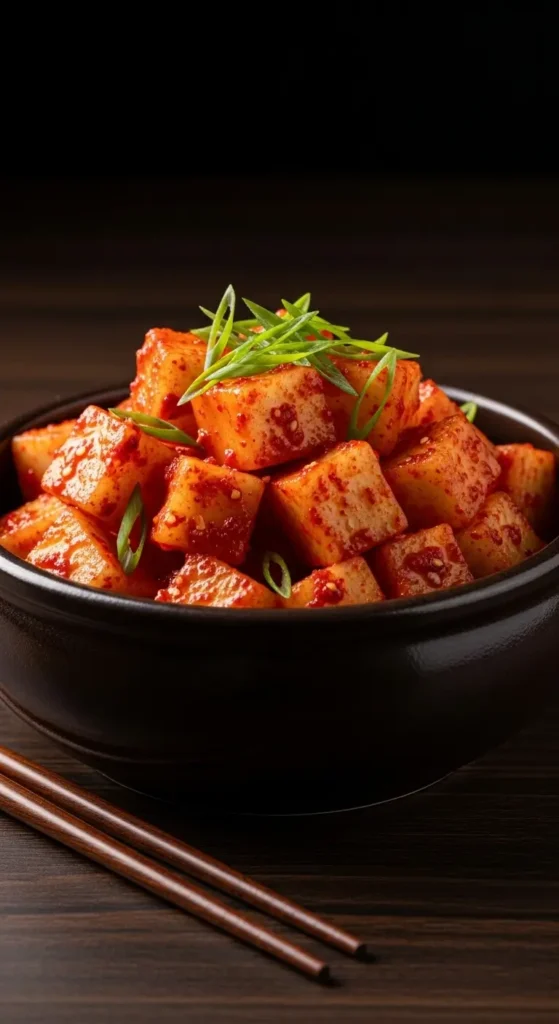
Fermentation Timeline for Radish Kimchi
Radish kimchi ferments a bit differently than cabbage. It usually hits its peak flavor after about 3-4 days chilling at room temperature, then it keeps developing more tang in the fridge. You can eat it fresh if you’re into milder flavors, or let it go for up to a week if you want it super sour.
The radishes will release liquid as they ferment, which creates this flavorful brine that’s honestly delicious added to soups. Don’t throw it out!
Learn more about: Fermented Cabbage Blends
White Kimchi for Mild Palates
Gentle Introduction to Fermented Foods
When comparing kimchi variations by spice level, baek kimchi is the answer for people who want all the probiotic goodness without their mouth catching fire. It skips the red pepper completely, so it’s perfect if you’re not big on spicy stuff. Instead, it gets its flavor from garlic, ginger, Asian pear, jujubes, and pine nuts.
What you get is this mild, slightly sweet kimchi that looks pale and beautiful. The cool thing is you’re still getting all those gut health benefits because the fermentation works the same way. It’s great for kids or anyone with a sensitive stomach who can’t handle the spicy versions.
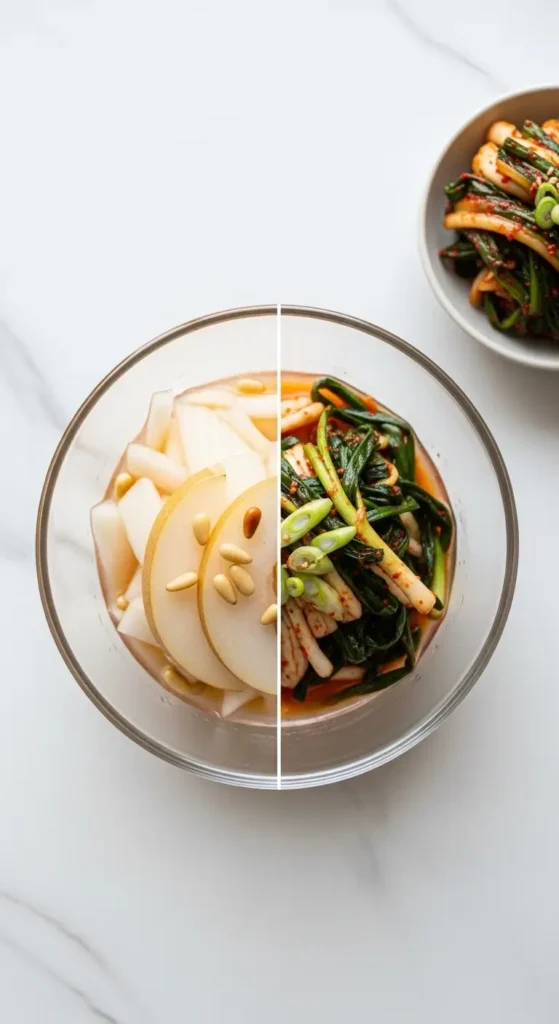
Ingredients That Add Flavor Without Heat
Without red pepper doing the heavy lifting, white kimchi relies on aromatics and fruits to make things interesting. Fresh ginger, garlic, Korean pear slices, and even chestnuts become the stars of the show. Some people throw in yellow Korean radish for extra sweetness and color.
A little bit of kelp adds that umami depth that usually comes from the gochugaru, so you’re not missing out on flavor at all.
Green Onion Kimchi in Minutes
Quick Fermented Side Dish
Pa kimchi is all about green onions (scallions), and it’s ridiculously fast to make. Cut your green onions into 2-inch pieces, coat them with gochugaru, garlic, ginger, and either fish sauce or soy sauce if you’re going vegan. Unlike cabbage or radish, green onions don’t need all that salting business.
You can seriously make this in about 15 minutes. It’s super tasty eaten fresh, though it gets even better after a day or two of fermenting. Talk about instant gratification!
Pairing Green Onion Kimchi
This stuff is perfect as a side dish for grilled meats, mixed into fried rice, or served with noodles. The green onions stay tender-crisp and pack a serious flavor punch in every bite. Plus, they’re loaded with vitamins K and C, along with sulfur compounds that help your body detox.
Water Kimchi for Refreshment
Soup-Style Fermented Vegetables
For those exploring unique kimchi variations, dongchimi or nabak kimchi are these cool water-based options that are more like a soup than what you’d expect. You’ve got radishes, napa cabbage, Asian pear, and sometimes cucumber all floating in this mildly seasoned brine.
The fermented liquid gets slightly fizzy (in a good way!) and you serve it in small bowls like a cold soup. It’s incredibly refreshing and works as a palate cleanser between rich or spicy dishes. Think of it as kimchi’s lighter, more refreshing cousin.
Health Benefits of Fermented Brine
The liquid in water kimchi is packed with probiotics from all that fermentation. Drinking it gives you digestive enzymes and beneficial bacteria that keep your gut happy. Plus, it’s hydrating and has electrolytes from the vegetables and salt, so it’s basically a natural sports drink (okay, maybe not quite, but close enough).
Discover great ideas like: Lacto Fermented Garlic Recipe
Vegan Temple-Style Kimchi
Plant-Based Fermented Goodness
Traditional Korean temple food has these vegan kimchi variations that skip the fish sauce, garlic, and green onions but somehow still taste amazing. They use stuff like kelp, ginger, green plum syrup, and Korean soup soy sauce (guk ganjang) to create that savory umami flavor.
So vegans can totally enjoy authentic fermented vegetables without compromising their diet. The fermentation still produces all those beneficial probiotics, so temple kimchi is just as healthy as the traditional stuff.
Building Umami Without Fish Sauce
Creating that savory depth in vegan kimchi takes a bit of layering. Dried kelp, mushroom powder, miso paste, or fermented soybean paste all work beautifully. Some recipes throw in sweet fruit like apple or pear to add complexity.
Using good quality sea salt really helps bring out the natural flavors of the vegetables too. It’s all about working with what you’ve got to build that depth without the fish sauce.
There you have it—seven different kimchi variations to get your fermented veggie fix! Whether you’re looking for something mild, something that’ll clear your sinuses, or something you can whip up in minutes, these options have got you covered. Time to get fermenting!
Health Benefits Across All Kimchi Variations
| Kimchi Type | Primary Vegetables | Probiotic Count | Best For |
|---|---|---|---|
| Napa Cabbage | Cabbage, Radish | 9-10 log CFU/g | General gut health |
| Cucumber | Cucumber | 8-9 log CFU/g | Summer refreshment |
| Radish Cube | Korean Radish | 9-10 log CFU/g | Digestive enzymes |
| White Kimchi | Cabbage, Pear | 9-10 log CFU/g | Mild introduction |
| Green Onion | Scallions | 8-9 log CFU/g | Quick preparation |
| Water Kimchi | Mixed Vegetables | 9-10 log CFU/g | Hydration, palate cleansing |
| Vegan Temple | Cabbage, Radish | 9-10 log CFU/g | Plant-based diets |
Here’s what’s really cool—basically all kimchi variations give you some pretty amazing health benefits, and it all comes down to fermentation. When kimchi ferments, you’re growing tons of good bacteria like Lactobacillus, Leuconostoc, and Weissella. Yeah, I know those sound super scientific, but trust me, they’re the heroes your gut needs.
Research shows that eating kimchi regularly actually kicks out bad bacteria in your digestive system while boosting the good ones. And here’s something wild—fermentation actually increases the vitamins! You end up with way more B vitamins and vitamin K2 than when you started. Pretty neat, right?
There’s more, though. The probiotics might help with weight management, boost your immune system, and even improve your mood through this whole gut-brain connection thing. Plus you’re getting fiber, antioxidants, and anti-inflammatory stuff from the veggies themselves, which helps protect against chronic diseases. Honestly, it’s kind of a superfood pretending to be a simple side dish.
FAQs
Conclusion
Exploring different kimchi variations really does open up this whole world beyond basic cabbage. Whether you like the refreshing crunch of cucumber kimchi, the satisfying bite of radish cubes, the gentle sweetness of white kimchi, or the quick green onion varieties, there’s definitely something for everyone.
These seven kimchi variations show how adaptable these fermented foods really are—different vegetables, spice levels, dietary needs, whatever. When you experiment with these kimchi variations, you’ll find new favorites while getting all those probiotic benefits that make kimchi such a nutritional powerhouse.
My suggestion? Pick one that sounds good, get the basic fermentation down, and then have fun creating your own versions. It’s seriously addictive!
Print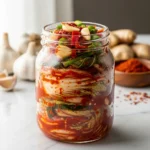
7 Creative Kimchi Variations to Spice Up Your Meals
- Total Time: 5 days
- Yield: Multiple jars
- Diet: Vegan
Description
Discover seven creative kimchi variations to elevate your meals. From classic napa cabbage to quick cucumber, crunchy radish, mild white kimchi, and vegan temple-style options, these fermented dishes add spice, flavor, and probiotics to any plate.
Ingredients
- Napa cabbage (for classic kimchi)
- Korean radish or daikon (for radish cube kimchi)
- Pickling or Persian cucumbers (for cucumber kimchi)
- Green onions (for green onion kimchi)
- Garlic, ginger, and green onions
- Korean red pepper flakes (gochugaru)
- Fish sauce or vegan soy alternatives
- Asian pear or apple (optional for sweetness)
- Sea salt and filtered water
- Kelp, miso paste, or soup soy sauce (for vegan kimchi)
Instructions
- Prepare your vegetables: wash, cut, and salt them as needed depending on the variation.
- Make a kimchi paste with gochugaru, garlic, ginger, and fish sauce or vegan substitutes.
- Coat vegetables thoroughly with the seasoning paste.
- Pack the mixture into clean jars, pressing down to remove air pockets.
- Cover loosely and ferment at room temperature for 1–5 days, depending on desired tanginess.
- Refrigerate once the flavor is where you like it to slow fermentation.
- Try different types: cucumber kimchi for quick crunch, radish cube for texture, or white kimchi for mild sweetness.
- Store all kimchi variations in the fridge, submerged in brine, for up to 3–6 months.
Notes
Adjust spice levels by changing the amount of gochugaru. White kimchi is perfect for mild palates, while cucumber kimchi ferments fastest. Use sea salt, filtered water, and fresh vegetables for best probiotic results.
- Prep Time: 30 minutes
- Cook Time: 0 minutes
- Category: Fermented Foods
- Method: Lacto-Fermentation
- Cuisine: Korean
Nutrition
- Serving Size: 2 tbsp
- Calories: 15
- Sugar: 1g
- Sodium: 150mg
- Fat: 0g
- Saturated Fat: 0g
- Unsaturated Fat: 0g
- Trans Fat: 0g
- Carbohydrates: 3g
- Fiber: 1g
- Protein: 1g
- Cholesterol: 0mg
Keywords: kimchi, kimchi variations, fermented vegetables, probiotics, Korean food, vegan kimchi
Sources
- Korean Bap Sang – 15 Easy Kimchi Recipes
- Kimchi Mari – 10 Kimchi Recipes with Different Vegetables
- The Sauce Mag – Korean Kimchi With 8 Variations
- NewsBytes – Spicy Korean Kimchi Variations
- Chelsea Green – How to Make Three Kinds of Kimchi
- Alibaba Spice – Global Kimchi Recipe Ingredients
- PubMed – Health Benefits of Kimchi as Probiotic Food
- Healthline – 9 Surprising Benefits of Kimchi
- Taylor & Francis – Does Kimchi Deserve Probiotic Food Status?
- NC State – Understanding and Making Kimchi
- Farmhouse on Boone – Best Easy Homemade Kimchi Recipe
- Wikipedia – Kimchi
- My Korean Kitchen – 14 Delicious Ways to Eat Kimchi
- Food52 – 21 Kimchi Recipes To Fire Up Dinner

